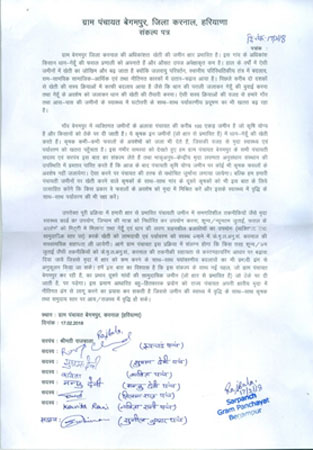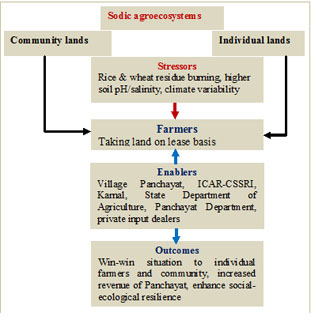
A considerable acreage of community lands of both Haryana and Punjab are affected by either sodicity or salinity or both. Such lands are being given on lease to the farmers on yearly basis where rice-wheat cropping system predominates. Farmers of Haryana who take community lands on lease (Rs. 25,000 to 35,000 per acre salt affected, while Rs. 30,000 to 40,000 per acre normal lands) are although progressive and adopt scientific technologies of rice-wheat cultivation, the yield of rice and wheat from salt affected community lands are low. For example land with pH 9.0 to 9.8 and soil carbon 0.22 to 0.68 yields 3.3 to 4.0 t/ha rice in coarse variety while in Basmati rice it yields 2.2 to 3.0 t/ha. In case of wheat, yield in salt affected lands could vary between 3.5 to 4.5 t/ha.
Looking to the stressors of such salt affected community lands, ICAR-Central Soil Salinity Research Institute, Karnal together with village Panchayat, Begampur, Karnal came forward to have participatory diagnosis of salt affected community lands. The 40 ha of community lands was sampled with GPS details and transect walk across the landscape. The abiotic stressors in terms of sodicity (pH2varied between 8.0 to 10.1 in the soil depth of 0-15 cm, while upto 10.5 in depth 15-30 cm.) and deficiency of soil nutrients and carbon were diagnosed of these soils. Results revealed that soil samples from community lands were low in soil organic carbon (SOC) (73.33%), whereas these soils were low in nitrogen (100.0%), zinc (66.7%), boron (86.7%), iron (33.3%) and manganese (93.3%) (Table1). Phosphorus (93.3%) and sulphar (60.0) were higher (Table 1).
These parameters were also observed low in individual farmer’s fields. To enhance the adaptive capacity of such agroecosystem, two rounds farmers Goshthis were organized during October and November 2017 to understand the agronomic practices of farmers where about 60 male and female farmers together with village Sarpanch and members, and other stakeholders namely State Agriculture Department, Private Input Suppliers and State Revenue Department officials actively participated. Based on the soil diagnosis data, the scientists from ICAR-CSSRI, Kanral shared the knowledge with other stakeholders on deficiency of soil nutrients and SOC of community lands caused by farmers’ practice of burning of full residue of rice crop and about 30.0% residue of wheat crop. A total of 25 soil health cards to male and female farmers along with required agroadvisories were provided in Goshthi held on 17th February.
In order to manage these stressors, the village Sarpanch in consultation with Dr. P. C. Sharma, Director ICAR-CSSRI, Karnal and Coordinator Dr. Ranjay K. Singh proposed to have consultancy services from ICAR-CSSRI Karnal to Village Panchayat (Begampur, Karnal) for detailed diagnosis of soil stressors and reclamative approaches for sodic soils to provide ecological and climate resilience agro-practices.
Table 1 Nutrient status of soils of community land where rice-wheat system prevails
|
|
Number of samples (%) |
|||||
|
Soil pH (1:2) |
Low |
Medium |
High |
Low |
Medium |
High |
|
Soil organic carbon |
Nitrogen |
|||||
|
Normal (<8.2) |
00.0 |
00.0 |
00.0 |
00.0 |
00.0 |
00.0 |
|
Sodic (>8.2) |
73.33 |
26.66 |
00.0 |
100.0 |
00.0 |
00.0 |
|
|
Phosphorus |
Potassium |
||||
|
Normal (<8.2) |
00.0 |
00.0 |
00.0 |
00.0 |
00.0 |
00.0 |
|
Sodic (>8.2) |
00.0 |
6.66 |
93.33 |
00.0 |
80.0 |
20.0 |
|
|
Sulphur |
Zinc |
||||
|
Normal (<8.2) |
00.0 |
00.0 |
00.0 |
00.0 |
00.0 |
00.0 |
|
Sodic (>8.2) |
20.0 |
26.66 |
60.0 |
66.66 |
6.66 |
00.0 |
|
|
Boron |
Iron |
||||
|
Normal (<8.2) |
00.0 |
00.0 |
00.0 |
00.0 |
00.0 |
00.0 |
|
Sodic (>8.2) |
86.66 |
13.33 |
00.0 |
33.33 |
13.33 |
6.66 |
|
|
Manganese |
Copper |
||||
|
Normal (<8.2) |
00.0 |
00.0 |
00.0 |
00.0 |
00.0 |
00.0 |
|
Sodic (>8.2) |
93.33 |
00.0 |
00.0 |
6.66 |
00.0 |
53.33 |
Note: The EC2 of soil varied between 0.22 to 0.68 20.0% zinc, 46.66 % iron, 6.66 % manganese and 40.0 % copper were found sufficient in above samples

As follow-up of this idea, the Village Sarpanch Mrs. Rajbala along with concept coordinator Dr Ranjay K. Singh organized a third round of farmers’ Goshthi (17th February 2018) to formally pass a resolution on Zero burning of crop residue (Fig. 1), and making other farmers aware about the role of crop residues in reclaiming soil pH, improving soil health and regulating other ecosystem services. In this Goshthi, about 225 farmers including 75 women and other stakeholders actively participated. Panchayat also assured that a condition of not to burn crop residues on community land will be incorporated while auctioning lands to individual farmers for rice-wheat cropping.
During the Goshthi, a review of works on soil health cards and gypsum requirements for community lands, and results of salt tolerant wheat variety KRL-210 (number of tillers, plant height, leaf shape and size, effective ear-head bearing tillers, etc.) which was provided to farm women free of cost, and farmers practicing rice-wheat on community lands was done. In order to effectively use the rice and wheat residues in the sodic lands managed by community, the knowledge on required machinery (improved mulcher and moderated seed drill for wheat) to be purchased by Village Panchayat and provided to the leasee farmers of community lands and individuals on custom hiring basis, and integration of agro-practices (knowledge on gypsum application, laser leveling, green manuring and direct seeded rice with salt tolerant rice Basmati variety CSR-30) to adapt impact of stresses caused by sodic agroecosystem and climate variability (intense rains during January and February affect wheat yield in sodic soils upto 20-30 %) were discussed in greater details. The interventions of ICAR-CSSRI were felt most necessary to enable farmers’ adaptations for these practices, and now complete technical know-how is being provided by CSSRI to village Panchayat and farmers for sustainable yields on salt affected lands. Farmers are being encouraged to form self-help groups to adopt salt tolerant wheat (KRL-210) and rice (CSR-30) varieties for the purpose of seed promotion for which appropriate training will also be provided.
This could be perhaps the first example where the expenses incurred in developing soil health cards of community lands at ICAR-CSSRI, Karnal was paid by the village Panchayat, Begampur. Further, it was assessed that the accurate amount of gypsum if applied into soil having high pH (e.g., 8.0 to 8.5 t/ha to neutralize pH2 8.4 to 9.6) along with integration of above stated agro-practices, may increase rice and wheat yields upto 15-20 per cent. Some farmers were observed to adapt muskmelon as relay crop with wheat in the furrow during February first week (wheat is harvested as fodder) to intensify income and reduce risk. The biomass of muskmelon after fruit harvest is mixed into soil during July, and thus it conserve soil and enrich SOC. As a result, the rate of auctioning of such community lands where planned (e.g. gypsum, salt tolerant varieties) and autonomous adaptation strategies (e.g. relay of muskmelon) are followed, may enhance the land value in auctioning as compared to present rate of Rs. 90,000 per ha for example in Begampur Village Panchayat. Leasee farmers who follow resilient practices on community lands need to be incentivized under the terms and conditions of Panchayat land auction. However, Village Panchayat needs scientific evidence to enact such policy while auctioning the land, and for which CSSRI may prove to be instrumental. Community members perceived that this way the revenue of community lands can be increased, and simultaneously the individual income of leasee farmers who practice rice-wheat on community lands can also be increased.
Members of Panchayat felt that sodic lands managed by community need to be covered under the subsidy policy on gypsum (Panchayat purchase gypsum on full market price) so as to enhance sustainable reclamation process of such lands. At present very few Panchayat apply gypsum in sodic community lands due to defunct institutional arrangements, higher cost involved in purchasing gypsum and no scientific support in diagnosing abiotic stressors and managing such lands. Participants from village during the Goshthis indicated that the institutional network of Village Panchayat can be evolved with ICAR-CSSRI and other related stakeholders to activate capacity development of Panchayat members with regards to diagnose abiotic stressors of community lands, receiving and passing on agroadvisories, maintaining database, and pursuing evidence based policies on sodic land management to increase revenue. The Village Panchayat members and scientists (ICAR-CSSRI, Kanral) opined that the experiment started on community lands of Begampur village (Karnal) with multi-stakeholders (farmers, village Panchayat, ICAR-CSSRI, Kanral, private input dealers and State Department of Agriculture) can provide a policy framework to the State Governments (Department of Panchayat) in the regions/state where similar problems exist about sustainable management of sodic lands. Such policy framework may provide win-win situations to individual farmers and community together from ecological and climate resilience point of views (Fig. 2) for rice-wheat cropping system practiced in sodic community lands.
(ICAR-Central Soil Salinity Research Institute, Karnal)








Like on Facebook
Subscribe on Youtube
Follow on X X
Like on instagram